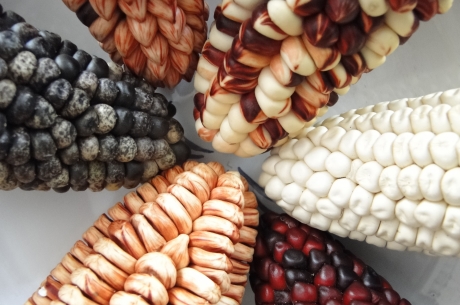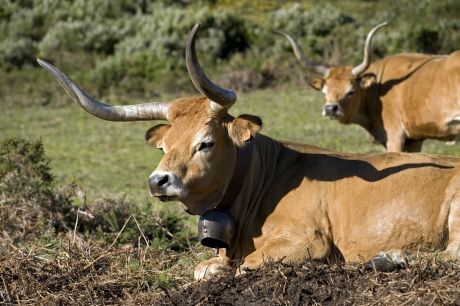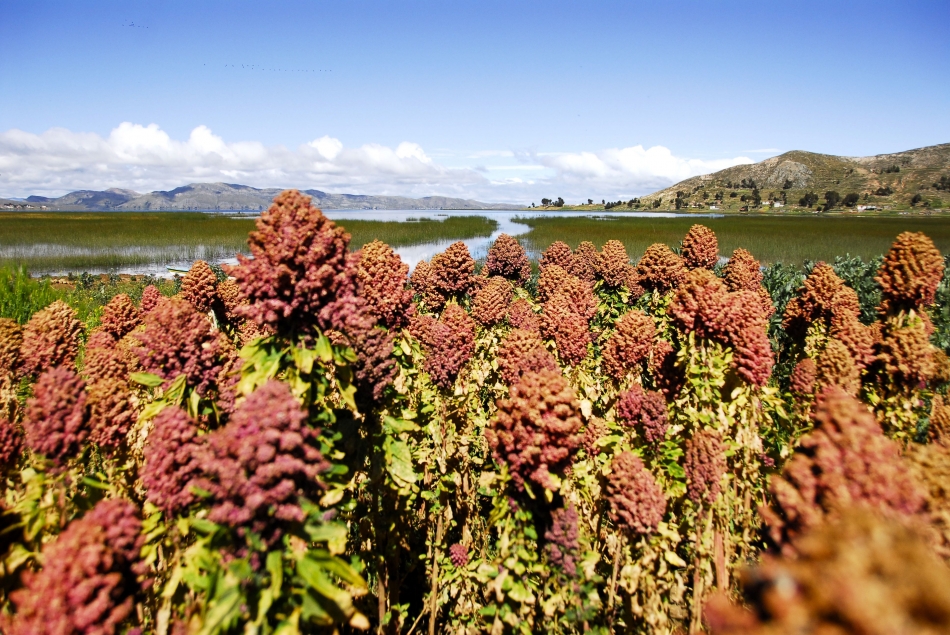When we say biodiversity, we mean the variety of plant and animal life in the world. A rich diversity of species, habitats and genetics means ecosystems that are healthier, more productive and better able to adapt to challenges like climate change. ©FAO/Alipio Canahua
One person has curly hair; one person has straight hair. One person tans, another burns. One person can curl her lip, another can’t. This is all because of our genes and the differences in them. Diversity. It is the spice of life.
Just like our own differences, plants and animals have differences too, ones that we may or may not see. One variety of rice, for example, is more resistant to flooding than another. One breed of cattle can withstand drought where another can’t. This is all thanks to biodiversity.
Biodiversity signifies the variety of plant and animal life in the world. It includes genetic, species and ecosystem variety. When there is a rich diversity of species, habitats and genetics, ecosystems are healthier, more productive and can better adapt to challenges like climate change.
More than just variety, biodiversity is also the way that different species, plants and animals, are connected and interact. The world is made of an invisible web that we rarely recognize. Loss of species, whether animal or plant, can change an entire ecosystem. It means the loss of connections.
Here are 7 ecosystem connections and contributions that you may not be aware of:
1. Agriculture & healthier soils – Agriculture is usually blamed for soil degradation. Yet, managed carefully, agriculture can actually increase the health of soils. Pulses, for example, help restore the vitality of soils, which in turn helps other plants better grow. Did you know that there are more living individual organisms in a tablespoon of soil than there are people on the earth? Healthy soils are needed to help our food grow, to take carbon out of the air and to provide microbes from which our medicines, like penicillin, are derived. The agricultural sectors are the biggest users of biodiversity. Together they manage the largest terrestrial, freshwater and marine areas on Earth, whether it is ‘wild’ biodiversity in forestry and fisheries or ‘domesticated’ biodiversity in production systems. If managed sustainably, agriculture can contribute to biodiversity conservation and important ecosystem functions.
2. Nutrition & climate change – Agricultural biodiversity, including wild relatives of crops, is fundamental for coping with a changing climate and securing our future of food. This diversity provides agriculture with crop varieties and livestock breeds that can better adapt to changes in temperature, precipitation and extreme weather events. It is also important in this age of change that we explore other types of crops. Of the approximately 400 000 plant species that have been identified, 30 000 are known to be edible. However, to date, only 6 000 have been used as food. However, worldwide, only 150 crops are cultivated on any significant scale! Astonishingly, only three crops (maize, wheat and rice) supply nearly 60 percent of our daily protein and calories. We need to expand our diets to explore some other varieties that could be more nutritious and could better cope with the changes in our climate.


If managed sustainably, agriculture can contribute to biodiversity conservation and important ecosystem functions. Left: ©FAO/Liana John; Right: ©Municipio de Boticas
3. Livestock & Seeds - We obviously know the importance of livestock as a food source. In fact, only three species - cattle, pigs, chicken - provide the majority of total calories in human diets, but you probably didn’t know that they help plants grow too! In browsing, grazing and nutrient cycling through production of manure, livestock can actually help distribute seeds. We often hear about the extinction of wild species, but livestock breeds have been affected as well. About 150 livestock breeds have gone extinct between 2000 and 2018.
4. Forests & clean water and purer air – Forests are one of the most important sources of biological diversity housing diverse habitats for plants, animals and micro-organisms. There are approximately 60 000 tree species in the world. Not only do forests protect various species, they act as natural filters that help purify our water sources. They also sequester and store carbon, cleaning and cooling the air. Losing forests means losing fresh sources of water. Currently, natural forests around the world have decreased from some 10.6 million hectares in the 1990s to 6.5 million hectares between 2010 and 2015. Restoring forests helps to ensure cleaner water and purer air, in addition to maintaining habitats for a large variety of species.
5. Poorly managed forests & decreased fish populations - Did you ever think that forests and fish are connected? Well they are! When forests are poorly managed, water flow becomes erratic. More sediment flows downstream and there is less freshwater delivered to other water sources like lakes and oceans. This negatively impacts fisheries, affecting the health or causing the death of certain types of fish. This means that there is less fish for human consumption. It also means that families who depend on fishing for their livelihoods face difficulty in providing for their families. Fish provide 20 percent of animal protein to about 3 billion people and almost 200 million people depend on fisheries and aquaculture for their livelihoods. Who knew that destroying forests can actually destroy the livelihoods of fishermen? Or that overfishing certain types of herbivore fish can reduce the dispersal of tree seeds?
6. Mangroves & Fewer Floods – Mangroves and other types of coastal vegetation, like sea grasses and salt marshes, can hold the coastal floors and reduce the size of waves, decreasing the chances or impact of coastal flooding. In fact, forests and agricultural lands reduce the risks and damage from floods, storms, tsunamis, avalanches, landslides and droughts. Expanding aquaculture is one main cause of mangrove deforestation. In general, growing communities, increased infrastructure development, water pollution, careless tourism and rising water acidity are all affecting coastal vegetation which ultimately means stronger impacts of natural disasters.

Biodiversity is needed to secure our future of food and nutrition. ©FAO/Claudio Guzman
7- Food security & biodiversity – Biodiversity of animals, fish or crops is actually an underlying necessity for our food production and food security. Having a diverse variety of crops, some that are more nutritious, or faster growing, some that are better adapted to drought or high-temperatures and other that need less water, are all needed to meet the challenges of climate change and growing populations. And it is not just crop varieties, it is the diversity in soils that helps plants grow, the variety in pollinators that helps plants reproduce and create the fruits and vegetables that we need so much; it is the diversity of insects some of which are natural enemies to the pests that can attack agricultural production. Biodiversity, it turns out, is needed to secure our future of food and nutrition.
Biodiversity needs to be part of the way we think about nature, human well-being and health. It needs to be part of our perspective, our policies and our laws. It is important to FAO to make biodiversity a concept that is known and readily recognized. As part of its commitment to biodiversity, FAO is supporting countries in creating good governance, enabling frameworks and stewardship incentives to include biodiversity in all agendas.
Taking for granted everything that nature does for the world threatens our own futures and the future of the environment. FAO is ensuring that biodiversity is taken into consideration at all levels so that we value what is seemingly invisible and make it known.
Learn more
- Sustainable Agriculture for Biodiversity
- FAO's work on biodiversity
- International Treaty on Plant Genetic Resources for Food and Agriculture
- Bee-ing grateful to our pollinators
- Oceans: our allies against climate change
- Building greener cities: nine benefits of urban trees
- Landscapes for life brochure
沒有留言:
張貼留言